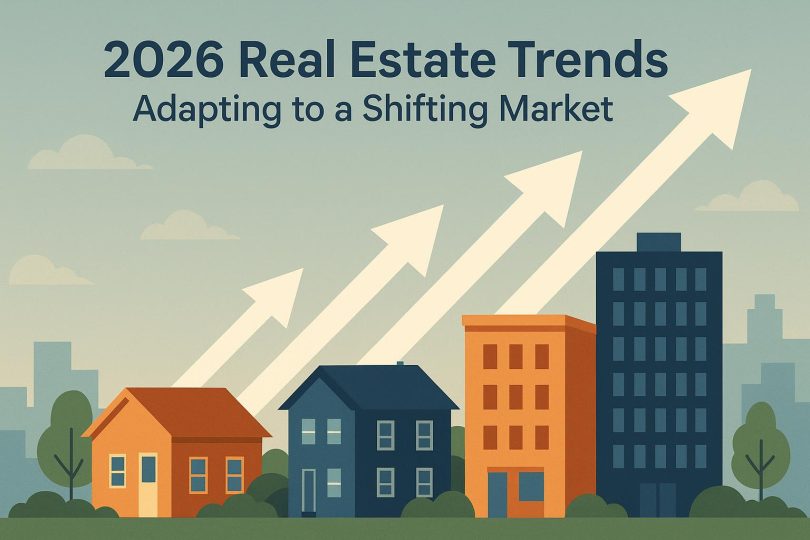Just as the real estate landscape continues to evolve, it’s vital for you to stay informed about the trends shaping the market in 2026. With shifts in buyer preferences, technology integration, and economic factors all playing significant roles, understanding these dynamics will empower you to make informed decisions. In this post, we will explore key trends that can impact your real estate strategies, ensuring you stay ahead of the curve in this ever-changing environment.
Overview of Current Market Dynamics
While the real estate landscape is constantly evolving, 2026 is presenting unique challenges and opportunities. Market dynamics are influenced by economic shifts, technological advancements, and changing consumer preferences. You need to stay informed about these trends to make wise decisions in your real estate endeavors, whether you’re buying, selling, or investing.
Economic Influences on Real Estate
Behind your real estate decisions lies a complex web of economic factors, including interest rates, inflation, and employment rates. These elements can significantly affect market stability and property values. As these variables change, you must adjust your strategies accordingly to navigate the shifting tides of the market at Coastal Cabana.
Demographic Shifts and Their Impact
Impact of demographic changes on the real estate market is profound. As population characteristics evolve, your target audience and their preferences will also shift, necessitating a closer look at what buyers and renters prioritize in their housing options.
Due to shifts in demographics, such as aging populations and the rise of millennials entering the housing market, preferences are becoming more diverse. For instance, you may notice a growing demand for multi-generational homes or sustainable living options. Understanding these trends can help you tailor your approach to meet market needs, influencing your investment decisions and marketing strategies. Adapting to these demographic changes will position you to benefit from emerging opportunities in the real estate landscape at River Modern.
Key Trends Shaping 2026
Assuming you keep an eye on the real estate landscape, various trends are reshaping the market as we approach 2026. You will notice that technology, sustainability, and changing consumer preferences are influencing how properties are developed, marketed, and sold. Adapting to these shifts will not only enhance your real estate strategies but also cater to the evolving demands of buyers and investors.
Technology Integration in Real Estate
Shaping the future of real estate, technology integration is transforming the way you interact with properties. From virtual reality home tours to blockchain transactions, these innovations create more efficient processes and enhanced user experiences, ensuring you stay competitive in the market.
Sustainable and Green Building Practices
One of the standout trends is the increased focus on sustainable and green building practices. You will find that environmentally friendly materials and energy-efficient designs are becoming a norm, appealing to eco-conscious buyers and investors alike.
Considering the growing awareness of climate change and its impacts, incorporating sustainable practices in your real estate ventures is more vital than ever. You should look into certifications like LEED (Leadership in Energy and Environmental Design) and explore the use of renewable energy sources. By offering properties that prioritize sustainability, you not only contribute to environmental well-being but also attract a broader audience seeking energy-efficient homes and commercial spaces.
The Rise of Remote Work and Its Effects
You may not realize it, but the shift to remote work is reshaping the real estate landscape in profound ways. As more companies embrace flexible work arrangements, individuals are rethinking where and how they live, leading to significant changes in demand for both residential and commercial properties. This trend is not just fleeting; it’s becoming a staple of modern life, and understanding these effects will be vital for navigating the 2026 real estate market.
Changes in Residential Preferences
Across the nation, homebuyers are prioritizing space and location over proximity to urban centers. With remote work allowing for greater flexibility, many are opting for larger homes in suburban or rural areas, seeking features such as home offices and outdoor spaces. This surge in demand is driving up property values in these previously less sought-after regions.
Impact on Commercial Real Estate
Before the rise of remote work, commercial real estate was largely defined by office space demand. Now, businesses are reassessing their office needs, leading to a decline in traditional office leases. Companies are exploring co-working spaces and smaller offices, prompting landlords to adapt their offerings to attract tenants in a changing marketplace.
At the same time, this shift is fostering innovative approaches in commercial real estate. Traditional office buildings may be repurposed for mixed-use developments featuring residential, retail, and office spaces. Landlords are also considering flexible lease options and amenities that cater to a more hybrid workforce. Understanding these dynamics will be vital for navigating investment opportunities in commercial real estate as we move toward 2026 and beyond.
Investment Strategies for a Shifting Market
After assessing the current shifts in the real estate market, it’s imperative for you to adapt your investment strategies accordingly. Embracing innovative avenues, evaluating local trends, and considering shifts in buyer behavior will provide you with a competitive edge. Evaluating your portfolio’s performance and being open to change will enable you to navigate fluctuating market conditions effectively.
Diversification and Risk Management
At this juncture, diversifying your investment portfolio is necessary to mitigate risk in a shifting market. By spreading your investments across various property types and geographic locations, you not only reduce your vulnerability to market volatility but also capitalize on different growth opportunities, ensuring a more stable financial future.
Emerging Markets and Opportunities
To maximize your investment potential, you should look toward emerging markets that show promising growth prospects. These areas often offer lower entry costs and higher returns compared to established markets, making them attractive for savvy investors. Identifying neighborhoods on the rise, or regions benefiting from infrastructure development can lead to lucrative opportunities.
Strategies for identifying emerging markets include analyzing demographic trends, job growth, and local government initiatives that stimulate economic growth. You should also monitor shifts in consumer preferences and investment activity in up-and-coming neighborhoods. By leveraging data and market insights, you position yourself advantageously to take advantage of these opportunities before they become mainstream, ensuring you remain ahead of the curve in your investment endeavors.
Regulatory Changes and Compliance
To successfully navigate the evolving real estate landscape, you must stay informed about emerging regulatory changes and compliance requirements. These shifts can significantly impact your investment strategies, property management practices, and overall business operations. Being proactive in understanding these regulations helps you avoid potential pitfalls and capitalize on opportunities in a rapidly shifting market.
Zoning Laws and Housing Policies
Housing policies and zoning laws are continually evolving, directly influencing property development and market values. As a real estate professional, you need to adapt to these changes by understanding local regulations, which can dictate everything from land use to density restrictions. Staying aware of new policies will enable you to make informed decisions and leverage potential investment opportunities.
Sustainability Regulations
Compliance with sustainability regulations is becoming increasingly important in the real estate market. You must be aware of local and federal standards that govern energy efficiency, waste management, and environmentally responsible construction practices. As consumers become more eco-conscious, complying with these sustainability regulations can enhance your property’s appeal and increase its market value.
The push for sustainability in real estate is not just a trend; it’s a regulatory shift that’s here to stay. The implementation of stricter energy codes, incentives for green building, and requirements for sustainable practices means you must integrate eco-friendly solutions into your projects. By prioritizing sustainability, you not only adhere to regulations but also attract a growing demographic of environmentally conscious buyers and tenants.
Preparing for Future Challenges
Unlike previous years, the real estate landscape in 2026 will likely demand a proactive approach to tackle emerging challenges. As you navigate these changes, staying informed and adaptable will be key to maintaining your competitive edge. By preparing for anticipated shifts, you can position yourself for success in an unpredictable market.
Economic Uncertainties
Across the real estate sector, economic uncertainties will continue to pose challenges that require strategic foresight. Interest rates, inflation, and market fluctuations will impact both buyers and sellers. As you assess your market position, understanding these economic factors will help you make informed decisions to safeguard your investments.
Adapting to Consumer Behavior Shifts
Uncertainties in the market have led to evolving consumer preferences, demanding a new approach to transactions. You must be attentive to shifts in what your clients value and seek in properties. Tailoring your offerings to meet these demands will be critical for success.
And as consumer behavior continues to change, leveraging technology and data analytics will enhance your insights into market trends. You should stay engaged with your audience through social media and personalized marketing strategies, allowing you to respond quickly to consumer needs. By doing so, you can foster trust and loyalty, leading to repeat business and referrals in this increasingly competitive environment.
Final Words
With these considerations in mind, you are better equipped to navigate the evolving landscape of real estate trends in 2026. Adapting to a shifting market will require you to stay informed about consumer preferences, technological advancements, and economic factors shaping the industry. By leveraging this knowledge, you can make more informed decisions, enhance your investment strategies, and ultimately thrive in a dynamic real estate environment. Stay proactive and responsive to changes, and you will position yourself for success in the years ahead.







